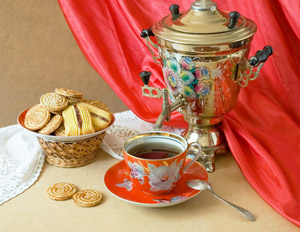
Since its introduction to Russia from China, tea has become a cultural staple. It is consumed at breakfast, lunch, dinner, and any hour in between. Russians traditionally drink strong black teas which they flavor with honey, sugar or jams. And one of the ways of preparing tea that has most been associated with Russia is the samovar.
The samovar came to Russia from Persia and the Middle East in the 18th century. The samovar is a a metal urn in which water is kept boiling for tea. Charcoal or wood is burned in a vertical pipe through the center of the samovar and this heats the water. On top of the samovar is a holder for a small teapot. In this pot, a strong tea concentrate is brewed. This tea essence is then diluted with hot water from the samovar.
In old Russia, in the days before mass production, tea drinking was a way of life. The samovar was a staple in homes, restaurants and offices. Samovars would be located on street corners to sell tea to passersbys. Even trains were equipped with samovars for their passengers.
The first samovars in Russia were imported and were very utilitarian in form. As is typical for the Russian people, they began to decorate and develop the samovar into a beautiful work of art, as welcome in the Winter Palace as in a peasant's izba. The first samovar was made in Tula in 1820. After a while, Tula became known as the center of Russian samovar production (in addition to the production of munitions and other metalworks). By 1900, there were 40 samovar factories in Tula with an anual production of around 630,000. The Batashev Metalworks, which became one of the most famous factories, produced 110,000 samovars alone each year.
Samovars came in various shapes and sizes depending on their use. Most were small, around 18 inches high, and were used in homes and offices. Larger samovars could be several feet in hight and diameter. Traveling samovars were equipped with handles and removable legs. Others had compartments for preparing food. The metalworkers of the Russian samovar factories provided exquisite detail in silver, bronze, and iron.
Modern day Russians still use the samovar quite often. However modern technology has provided for electric samovars which don't require the use of charcoal. As in old, these samovars are found in kitchens, offices, and even on Russian Trains. And the use of the samovar has spread from Russia to much of Eastern Europe.